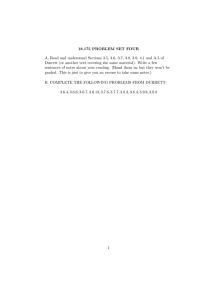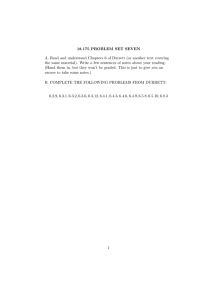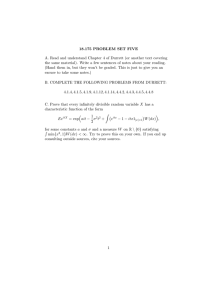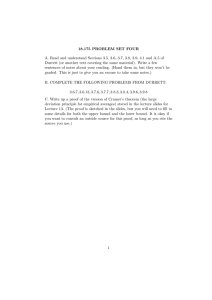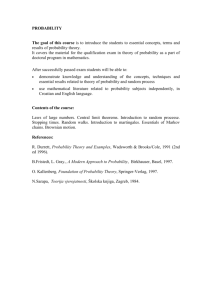Solution
advertisement
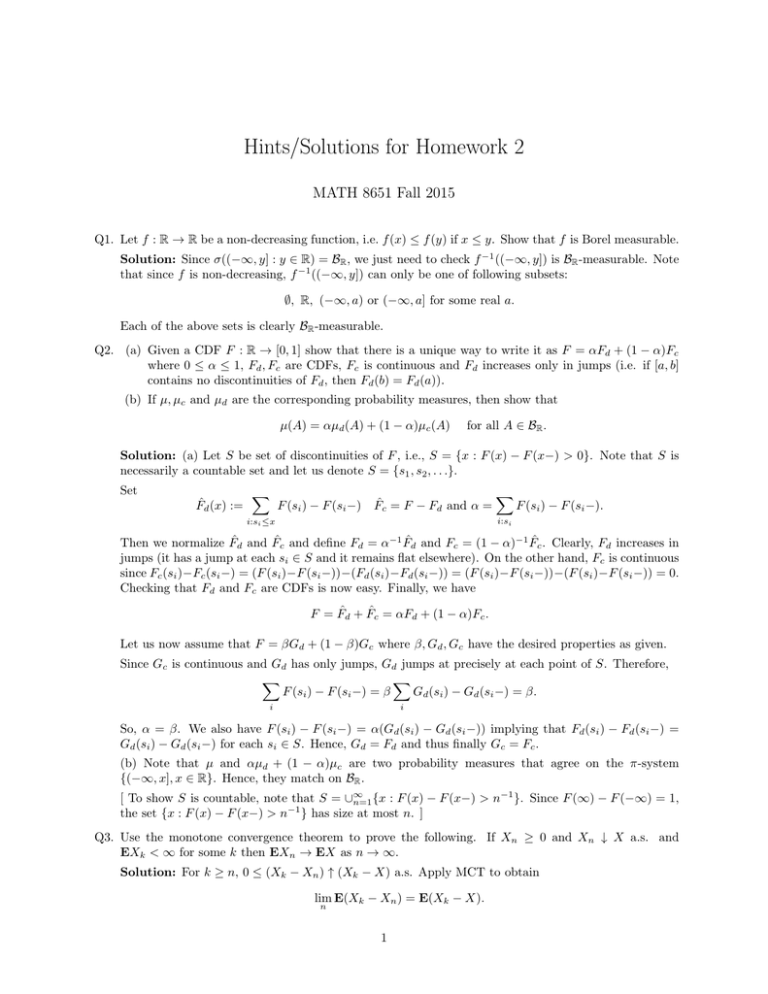
Hints/Solutions for Homework 2
MATH 8651 Fall 2015
Q1. Let f : R → R be a non-decreasing function, i.e. f (x) ≤ f (y) if x ≤ y. Show that f is Borel measurable.
Solution: Since σ((−∞, y] : y ∈ R) = BR , we just need to check f −1 ((−∞, y]) is BR -measurable. Note
that since f is non-decreasing, f −1 ((−∞, y]) can only be one of following subsets:
∅, R, (−∞, a) or (−∞, a] for some real a.
Each of the above sets is clearly BR -measurable.
Q2. (a) Given a CDF F : R → [0, 1] show that there is a unique way to write it as F = αFd + (1 − α)Fc
where 0 ≤ α ≤ 1, Fd , Fc are CDFs, Fc is continuous and Fd increases only in jumps (i.e. if [a, b]
contains no discontinuities of Fd , then Fd (b) = Fd (a)).
(b) If µ, µc and µd are the corresponding probability measures, then show that
µ(A) = αµd (A) + (1 − α)µc (A)
for all A ∈ BR .
Solution: (a) Let S be set of discontinuities of F , i.e., S = {x : F (x) − F (x−) > 0}. Note that S is
necessarily a countable set and let us denote S = {s1 , s2 , . . .}.
Set
F̂d (x) :=
X
F (si ) − F (si −) F̂c = F − Fd and α =
i:si ≤x
X
F (si ) − F (si −).
i:si
Then we normalize F̂d and F̂c and define Fd = α−1 F̂d and Fc = (1 − α)−1 F̂c . Clearly, Fd increases in
jumps (it has a jump at each si ∈ S and it remains flat elsewhere). On the other hand, Fc is continuous
since Fc (si )−Fc (si −) = (F (si )−F (si −))−(Fd (si )−Fd (si −)) = (F (si )−F (si −))−(F (si )−F (si −)) = 0.
Checking that Fd and Fc are CDFs is now easy. Finally, we have
F = F̂d + F̂c = αFd + (1 − α)Fc .
Let us now assume that F = βGd + (1 − β)Gc where β, Gd , Gc have the desired properties as given.
Since Gc is continuous and Gd has only jumps, Gd jumps at precisely at each point of S. Therefore,
X
X
F (si ) − F (si −) = β
Gd (si ) − Gd (si −) = β.
i
i
So, α = β. We also have F (si ) − F (si −) = α(Gd (si ) − Gd (si −)) implying that Fd (si ) − Fd (si −) =
Gd (si ) − Gd (si −) for each si ∈ S. Hence, Gd = Fd and thus finally Gc = Fc .
(b) Note that µ and αµd + (1 − α)µc are two probability measures that agree on the π-system
{(−∞, x], x ∈ R}. Hence, they match on BR .
−1
}. Since F (∞) − F (−∞) = 1,
[ To show S is countable, note that S = ∪∞
n=1 {x : F (x) − F (x−) > n
−1
the set {x : F (x) − F (x−) > n } has size at most n. ]
Q3. Use the monotone convergence theorem to prove the following. If Xn ≥ 0 and Xn ↓ X a.s. and
EXk < ∞ for some k then EXn → EX as n → ∞.
Solution: For k ≥ n, 0 ≤ (Xk − Xn ) ↑ (Xk − X) a.s. Apply MCT to obtain
lim E(Xk − Xn ) = E(Xk − X).
n
1
For any n ≥ k, E(Xn ) ≤ E(Xk ) < ∞. Also, E(X) ≤ E(Xk ) < ∞. Thus, we have
E(Xk ) − lim E(Xn ) = E(Xk ) − E(X),
n
yielding EXn → EX as n → ∞.
Q4. Suppose an integrable r.v. X is such that E[X1A ] = 0 for any A ∈ σ(X). Show that X = 0 almost
surely.
(Hint: First try to solve Durrett exercise 1.4.1)
Solution: Take A = {X ≥ 0} and A = {X < 0} to obtain that E[X + ] = E[X − ] = 0. So, it boils
down to show that if Y ≥ 0 is a r.v. and E[Y ] = 0, then Y = 0 a.s. Suppose, if possible, assume that
P(Y > 0) > 0. Since P(Y > n−1 ) ↑ P(Y > 0) > 0, there exists some n ≥ 1 and > 0 such that
P (Y > n−1 ) ≥ . Clearly, n−1 1{Y >n−1 } ≤ Y . By monotonicity of the expectation,
EY ≥ E[n−1 1{Y >n−1 } ] = n−1 P(Y > n−1 ) = n−1 > 0,
contradicting the fact that E[Y ] = 0.
Q5. (a) Let (Ω, F, P) be a probability
Pn space and let Ai ∈ F for i = 1, 2, . . . , n. Compute the variance of
the random variable X = i=1 1Ai in terms of the probabilities P(Ai ) and P(Ai ∩ Aj ), i 6= j.
(b) If k balls are put at random into n boxes with replacements (i.e. one box may contain more than
one ball), what is the variance of X = number of empty boxes?
Solution: (a)
Var(X) = E[X 2 ] − E[X]2 = E[
X
X
1Ai 1Aj ] − (E[
1Ai ])2
i,j
= E[
X
1Ai ∩Aj ] − (E[
X
i,j
=
X
=
X
i
1Ai ])2
i
P(Ai ∩ Aj ) − (
X
i,j
P(Ai ))2
i
P(Ai ∩ Aj ) +
X
X
P(Ai ) − (
P(Ai ))2
i
i6=j
(b) Let Ai = { box i is empty }. We compute P(Ai ) =
for i 6= j. Plugging in, we obtain
i
n−1 k
n
for each i and P(Ai ∩ Aj ) =
n−2 k
n
Var(X) = n(n − 1)(1 − n2 )k + n(1 − n1 )k − n2 (1 − n1 )2k .
Q6. Durrett 1.4.3
Solution: (1) By definition,
Z
Z
+
g (x)dx = sup{ ϕ(x)dx : ϕ is simple function , 0 ≤ ϕ ≤ g} < ∞.
R
R
Thus for any > 0, we can get a nonnegative simple function ϕ1 such Rthat |g + − ϕ1 |dx < /2.
Similarly, we can choose
another nonnegativeP
simple function ϕ2 such that |g − − ϕ2 |dx < /2. Define
R
n
ϕ = ϕ1 − ϕ2 . Thus |g − ϕ|dx < . Let ϕ = k=1 bk 1Ak where the representation in unique if bk ’s are
all distinct non-zero real numbers and Ak ’s are disjoint. The integrability of g implies that λ(Ak ) < ∞
for each k where λ is the Lebesgue measure on R.
(2) Define A = the collection of finite disjoint unions of intervals of the form (a, b] such that −∞ ≤
a < b ≤ +∞. Note that A is a field that generates BR . Take M = maxk |bk |.
2
By Lemma A.2.1
R for each subset Ak as above, there exists Bk ∈ A such that λ(Ak ∆Bk ) <
P (b) of Durrett,
.
Let
q
=
b
B
.
Then
|ϕ − q| < . Finally, observe that since Bk is a finite union of (disjoint)
k
k
k
Mn
R
intervals, the function q is a step function with finitely many steps.
Comment: If you don’t want to use Lemma A.2.1, you can also use Q3 of Homework 1. First of all,
note that the proof of Q3 remains valid for any finite measure. Then find n ≥ 1 large enough such
that λ(Ak ) − λ(Ak ∩ (−n, n]) < /2. Consider the finite probability space (R, BR , λn ) where λn is the
restriction of λ on (−n, n]. Use Q3 to get an approximation Bk ∈ A such that λn (Ak ∆Bk ) < /2. Set
A0k = Ak ∩ (−n, n] and Bk0 = Bk ∩ (−n, n] ∈ A. Note that λ(A0k ∆Bk0 ) = λn (A0k ∆Bk0 ) = λn (Ak ∆Bk ) <
/2. Therefore λ(Ak ∆Bk0 ) ≤ and Bk0 ∈ A.
(3) This is how one can approximate a function 1(a,b) by “rounding its corner” of its graph. Fix > 0.
Set φ(x) = 1 for x ∈ [a, b], φ(x) = 1 − (x − b)/ for x ∈ [b, b + ] and φ(x) = R1 + (x − a)/ for x ∈ [a − , a]
and φ(x) = 0 elsewhere. Clearly, φ is continuous function and check that |φ − 1(a,b) |dx = . The rest
is easy.
Q7. Durrett 1.5.2
Solution: µ{|f | > kf k∞ } = 0. Hence, |f | ≤ kf k∞ a.s. implying that for any p > 0, kf kp ≤ kkf k∞ kp =
kf k∞ . For any > 0, µ{|f | > kf k∞ − } > 0. Note that
|f | ≥ (kf k∞ − )1{|f |>kf k∞ −} .
Therefore, for any p > 0,
kf kp ≥ k(kf k∞ − )1{|f |>kf k∞ −} kp ≥ (kf k∞ − ) µ{|f | > kf k∞ − }
1/p
→ kf k∞ − as p → ∞. Since > 0 arbitrary, kf kp → kf k∞ .
Q8. Durrett 1.6.6
Solution: Applying Cauchy-Schwarz,
(E[Y 1{Y >0} ])2 ≤ E[Y 2 ]E[1{Y >0} ] = E[Y 2 ]P(Y > 0).
Since Y ≥ 0, Y = Y 1{Y >0} and hence E[Y 1{Y >0} ] = EY . Thus, we get the inequality,
(EY )2 ≤ E[Y 2 ]P(Y > 0)
or,
P(Y > 0) ≥
(EY )2
.
E(Y 2 )
Q9. Durrett 1.6.8
R
R
Solution:
We
µ(B) =
R
R first check thatR g = 1B for B ∈ B. For all g(x)µ(dx) = 1B (x)µ(dx)
P=
n
f
(x)dx
=
1
(x)f
(x)dx
=
g(x)f
(x)dx.
Use
the
linearity
check
the
equality
for
g
=
ci 1Bi .
B
B
R i=1
Now,
for g ≥ 0, take a sequence of simple functions 0 ≤ gn ↑ g. Now by MCT, Rg(x)µ(dx) =
R
+
−
g(x)f
R ± (x)dx. Now
R ±for general g, represent g = g − g . By previous step and usingR |g|dµ < ∞,
R g (x)µ(dx) = g (x)f (x)dx < ∞. Taking the difference, we finally conclude that g(x)µ(dx) =
g(x)f (x)dx.
3
